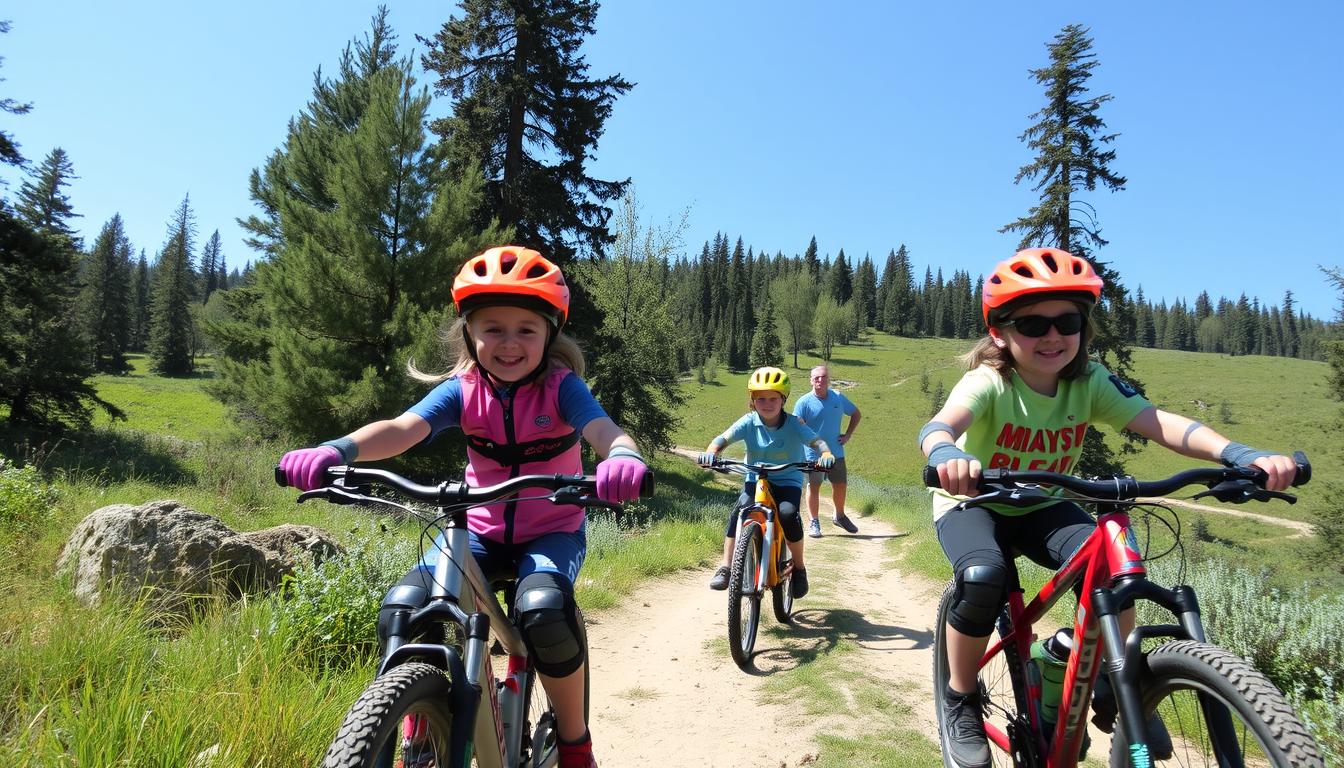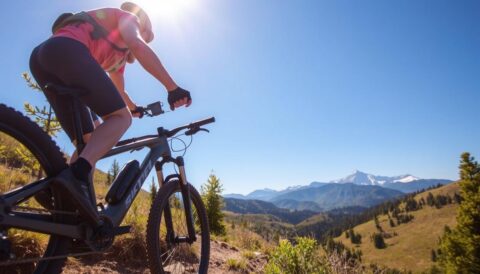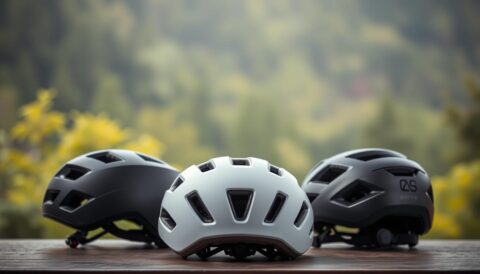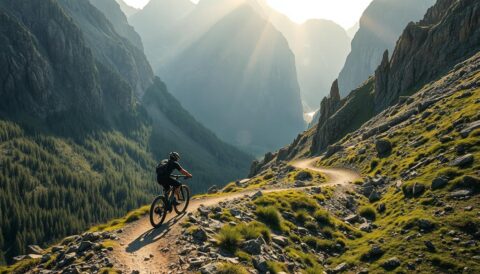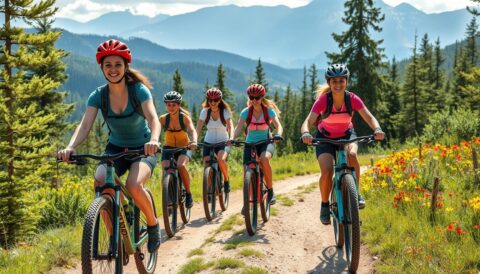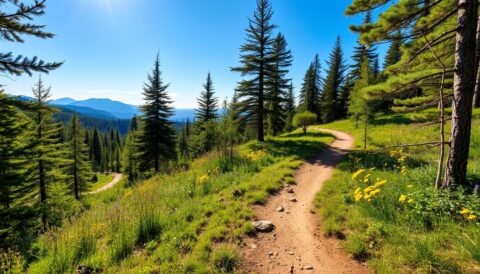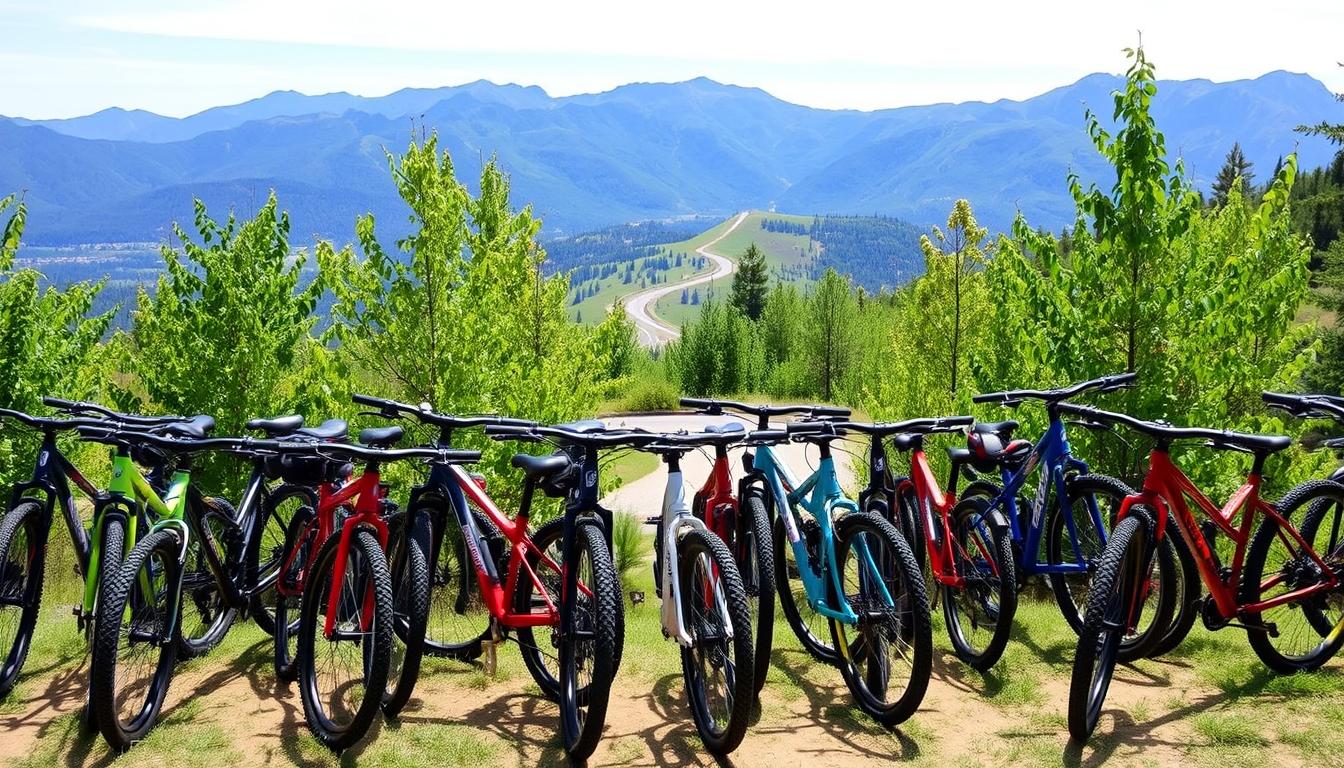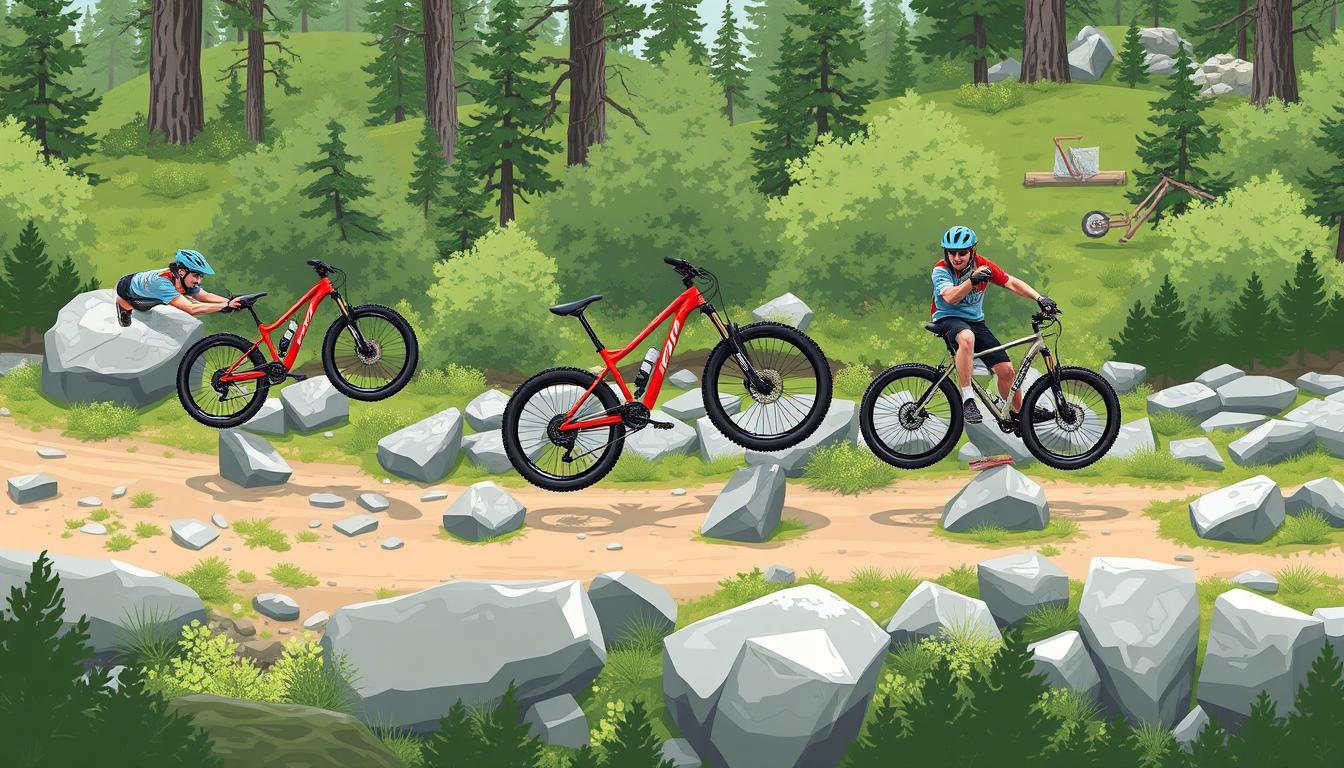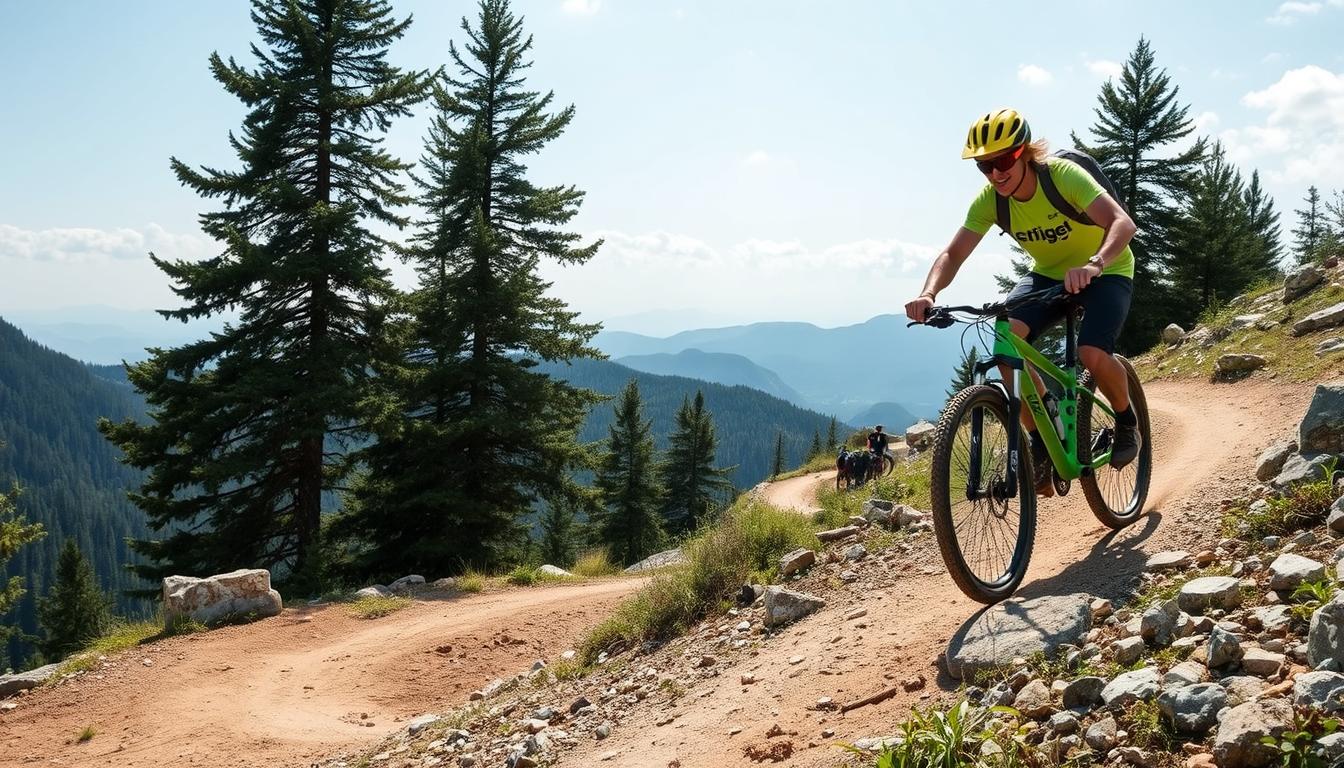Mountain biking offers kids a thrilling outdoor experience. It combines physical fitness with adventure. Safe mountain biking requires careful planning and gradual skill development1.
Children can gain coordination, balance, and confidence through mountain biking1. Balance bikes provide an excellent foundation for young riders2. Most children move to pedal bikes between ages 5 and 72.
Start with smooth, flat trails to build confidence and skills1. Remember, every child learns differently. Patience is crucial in their cycling journey3.
Proper equipment is vital for safe mountain biking. Invest in a well-fitted helmet and appropriate bike size1. Choose bikes with features suitable for your child’s age and skill level2.
Mountain biking can create lasting family memories. It promotes active lifestyles and outdoor exploration. With the right approach, children can develop a lifelong passion for cycling3.
Essential Safety Gear and Equipment for Young Riders
Mountain biking thrills children, but safety is crucial. Proper kids mountain bike safety gear can greatly lower injury risks. It ensures a fun and secure riding experience.
Selecting the right safety equipment protects young riders. Age-appropriate mountain bikes and comprehensive protective gear create a secure cycling foundation. This combo allows for safe and enjoyable adventures.
Choosing the Right Helmet
Helmets are vital for preventing serious head injuries. They can stop up to 85% of head injuries when used correctly4. Parents should choose helmets with Consumer Product Safety Commission standards.
Over 80% of helmets without a CPSC sticker fail tests4. Look for helmets with proper fit and adjustment. Ensure a comfortable size-adjustment dial and a snug chin strap.
- Select a helmet with proper fit and adjustment
- Ensure a comfortable size-adjustment dial
- Check for a snug chin strap with minimal gap
Essential Protective Wear
Comprehensive protection includes more than just helmets. Brightly coloured clothing makes children 2.5 times more noticeable to drivers4. This visibility boost is crucial for road safety.
| Protective Item | Injury Reduction |
|---|---|
| Shin Guards | Reduce lower extremity injuries by 60%4 |
| Full-Finger Gloves | Decrease hand injuries by 50%4 |
| Eye Protection | Reduce ocular injury risk by 75%4 |
Age-Appropriate Bike Selection
Choosing the right mountain bike for a child is vital. The bike should fit the child’s size, skill level, and physical abilities. This match ensures comfortable and safe riding.
Safety Accessories
Extra safety accessories can boost protection significantly. LED lights cut nighttime accident chances by 70%4. Bike bells lower collision risks by 40%4. These simple add-ons make a big difference.
Remember, proper gear transforms mountain biking from a risky activity to an exciting, safe adventure for children.
Getting Started: The Balance Bike Phase
Balance bikes are a game-changer for toddlers learning to mountain bike. These simple bikes help kids develop crucial cycling skills. Children can start riding as early as 18 months, with height being the key factor.
Balance bikes have a simple design that’s perfect for young riders. They teach essential skills without the complexity of pedals. Most children quickly learn to glide, enjoying the thrill of movement in no time.
- Start with a lightweight bike that’s no more than 30% of the child’s body weight5
- Ensure proper bike fit with 1-1.5 inches of frame clearance6
- Practice on gentle surfaces like grassy slopes7
Parents can boost their child’s confidence through structured learning experiences. Most parents report increased outdoor engagement after introducing balance bikes. Regular practice helps children develop coordination and control.
The key is patience and making the learning process enjoyable for young riders.
As children grow more confident, they’ll tackle more challenging terrain. Balance bike skills create a solid foundation for future mountain biking adventures. Remember, every child develops differently, so focus on individual progress and enjoyment.
Beginner Mountain Biking for Kids: Basic Skills Development
Teaching children mountain biking requires a step-by-step approach. Mountain biking skills for kids boost confidence and ensure trail safety8.
Young riders aged 8 to 13 can start learning mountain bike basics. Carefully designed programmes help break down complex techniques into simple steps.
Skill development is crucial for young mountain bikers. It helps them master the sport safely and enjoyably.
Mastering the Ready Position
The ready position is key to mountain biking technique. Children should learn this vital skill first.
- Keep feet level on pedals
- Bend knees slightly
- Maintain a relaxed grip on handlebars
- Look ahead on the trail
Learning Brake Control
Safe riding depends on good brake control. Kids need to practise this essential skill.
- Gentle, progressive braking
- Using front and rear brakes simultaneously
- Avoiding sudden, hard stops
| Skill Level | Key Learning Objectives |
|---|---|
| Beginner | Balance and basic control |
| Intermediate | Trail navigation and obstacle management |
Basic Trail Navigation Skills
Confidence grows with practice. Mountain biking clinics often use small groups for better skill development8.
This approach ensures each child gets enough attention. It helps them learn and improve faster.
Learning mountain biking is a journey of progressive challenges and personal growth.
Selecting Appropriate Trails for Young Riders
Picking suitable mountain bike trails is vital for young riders’ confidence and enjoyment. Beginner routes should offer a gentle start to off-road cycling. Safety and fun are key factors to consider9.
- Look for wide, smooth paths with minimal technical challenges
- Prioritise trails with gentle gradients
- Seek out local pump tracks or skills parks for initial practice9
Some exceptional beginner-friendly trail locations include:
- Sylaward: Offers 15 miles of beginner-friendly singletrack10
- Sweetwater Preserve: 8 miles of smooth trails with scenic views10
- Springhill Park: Known for smooth, fast singletrack without technical obstacles10
Repetition is key to building confidence on bike trails9.
Riding with peers of similar ages and abilities can boost the learning experience. Parents should plan snack stops and carry emergency supplies for kids’ bikes9.
Pro tip: Use towing devices like TowWhee to help with tough climbs. This can keep young riders motivated during challenging sections9.
Teaching Proper Mountain Biking Techniques
Advancing mountain biking skills for children requires a strategic approach. It builds confidence and competence in young riders. They’ll need to master sophisticated riding skills to enhance their performance and enjoyment11.
Mountain biking techniques for kids involve adapting to different terrains and challenges. Learning these skills takes time. Children typically need 6-12 months to develop adequate trail riding capabilities11.
Body Positioning Fundamentals
Proper body positioning is crucial for safe and effective mountain biking. Children should learn essential skills for success.
- Maintain a balanced stance
- Adjust weight distribution on different terrains
- Keep arms and legs flexible for shock absorption
Gear Shifting Skills
Teaching children bike handling skills includes understanding gear shifting. Kids should learn efficient gear changes through progressive training techniques.
| Terrain Type | Recommended Gear Strategy |
|---|---|
| Uphill | Lower gears for easier pedalling |
| Flat Ground | Medium gears for consistent speed |
| Downhill | Higher gears for controlled descent |
Obstacle Management Techniques
Navigating obstacles requires specific skills. Practice and patience are key to building confidence. Children can learn to manage roots, rocks, and small drops effectively12.
Remember, skill development is a journey, not a destination!
Parents can help children improve their mountain biking techniques through structured learning. Creating a supportive environment fosters a lifelong passion for the sport11.
Building Confidence Through Progressive Challenges
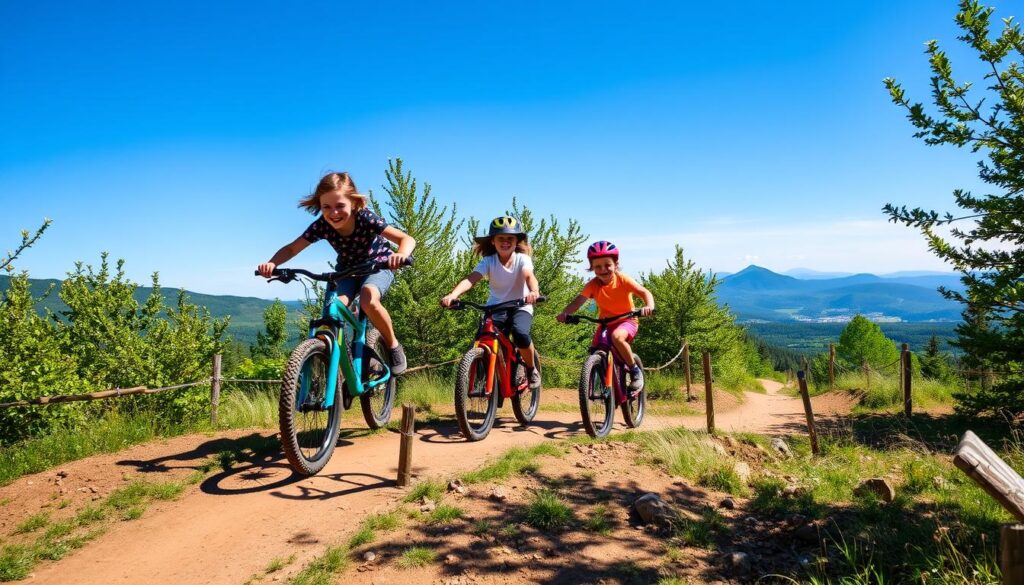
Boosting kids’ mountain biking skills needs a clever plan. It’s all about building confidence for young riders. This journey involves creating a supportive space where children can grow their abilities step by step.
Setting reachable goals is vital for young riders. Studies show goal-setting can increase motivation by up to 20%. Parents can help by creating small challenges and celebrating each win.
- Creating small, manageable challenges
- Celebrating each milestone
- Encouraging consistent practice
Skill development is crucial for building confidence. Regular practice of bike handling drills can improve trail performance by 30%. Try these progressive challenges:
- Timing runs on familiar trails
- Learning new techniques in controlled environments
- Participating in junior mountain biking events13
“Falling is part of learning. Each mistake is an opportunity to become a better rider.”
Visualization techniques can boost performance by about 24%. They help young cyclists build mental confidence. Remind kids that setbacks are normal and part of learning.
The aim is to create a positive atmosphere. This encourages perseverance and enjoyment in mountain biking. With the right support, young riders can conquer challenges and grow their skills.
Family-Friendly Biking Destinations and Skills Parks
Family mountain biking destinations offer thrilling adventures for young riders and parents alike. Choosing the right bike parks for kids involves balancing skill levels, safety, and fun14.
Choosing the Right Venue for Practice
Families should seek parks with varied trail options. Truckee Bike Park offers professionally designed trails for different skill levels15.
Key factors to consider include trail difficulty, safety features, and coaching opportunities. Don’t forget to check bike rental and equipment options too.
- Trail difficulty levels
- Safety features
- Available coaching opportunities
- Bike rental and equipment options
Making Use of Bike Park Features
Modern bike parks boast specialised features to boost young riders’ skills. Many parks include exciting elements for skill development.
| Park Feature | Skill Development |
|---|---|
| Pump Tracks | Balance and momentum control |
| Skills Courses | Technical riding techniques |
| Progressive Jump Lines | Confidence building |
Planning Family Biking Adventures
Proper preparation is key for enjoyable family mountain biking. Consider appropriate bike sizes for children14.
Kids’ bikes usually come in 20-inch and 24-inch wheel sizes, suiting different age groups14. Here are some helpful tips:
- Pack appropriate safety gear
- Choose beginner-friendly trails
- Start with short riding sessions
- Participate in community biking events
Mountain biking is not just a sport, it’s a family adventure waiting to happen!
Pro tip: Find parks hosting Take a Kid Mountain Biking Day events to introduce children to cycling joy15.
Conclusion
Mountain biking transforms physical activity into an exciting adventure for kids. It offers remarkable benefits beyond simple exercise. Children can grow personally and develop new skills through this thrilling outdoor sport1617.
Kids strengthen muscles and improve cardiovascular health whilst mountain biking. They also enhance coordination through engaging outdoor experiences18. These benefits contribute to overall physical fitness improvement.
Patience and supportive guidance are key to fostering a lifelong love for cycling. Professional coaching helps children build confidence gradually. It ensures they learn skills safely and maintain enthusiasm for the sport16.
Parents can introduce age-appropriate challenges to help children develop resilience. Maintaining a positive environment is crucial. This approach helps kids build self-assurance through mountain biking17.
Mountain biking teaches children valuable life lessons. They learn about perseverance, risk assessment, and personal challenge. Regular cycling can support mental well-being and reduce stress1618.
This sport provides a healthy alternative to sedentary electronic activities. With the right approach, mountain biking becomes a transformative experience. It supports holistic childhood development, going beyond just being a sport.
FAQ
At what age can children start mountain biking?
Children can begin with balance bikes from 18 months old. They can move to pedal bikes around 4-6 years old. Start with age-appropriate equipment and gentle terrain that matches their skills and confidence.
What safety gear is absolutely essential for kids mountain biking?
Essential safety gear includes a properly fitted helmet, knee and elbow pads, gloves, and closed-toe shoes. A well-fitted helmet is crucial to prevent head injuries.
How do I choose the right mountain bike for my child?
Choose a bike based on your child’s height and inseam measurement, not age. Look for lightweight bikes with the correct wheel size, typically 16-24 inches. Ensure they can touch the ground comfortably when seated.
Are balance bikes really necessary before mountain biking?
Balance bikes are very helpful for children. They develop core skills like balance, steering, and coordination without pedalling. These bikes build confidence and make the switch to pedal bikes easier.
How can I make mountain biking fun and safe for my kids?
Choose easy trails and provide proper instruction. Use positive reinforcement and let children progress at their own pace. Make safety fun by treating it as an adventure.
What are the best beginner trails for children?
Seek wide, smooth trails with few obstacles and gentle slopes. Local parks, smooth forest roads, and beginner mountain bike trails are great for young riders.
How often should my child practice mountain biking?
Aim for short, fun sessions of 30-60 minutes, 1-2 times per week. As skills improve, slowly increase the length and difficulty of rides.
What should I do if my child is afraid of mountain biking?
Never force the activity. Start with positive experiences and use patience. Provide lots of encouragement and break skills into small, manageable steps. Consider joining family-friendly mountain bike groups for support.
Are there specific mountain biking skills parks for children?
Many bike spots now have skills parks for children. These areas have pump tracks, gentle jumps, and learning zones. They’re designed to help kids build confidence safely.
How much should I invest in mountain biking equipment for my child?
Start with mid-range, lightweight equipment. Consider second-hand bikes or rental options as children grow quickly. Focus on safety gear over expensive bikes. Invest in items that can be adjusted as they grow.
Source Links
- How to Get Started Mountain Biking with Kids • RUN WILD MY CHILD
- How to Teach a Kid to Mountain Bike – Mountain Mom and Tots
- How To Introduce Your Kids To Mountain Biking- Biking Kids
- Equipment for Keeping your Kids Safe While Mountain Biking
- Balance bike parents: 3 tell-tale signs your child is ready to pedal
- A Beginner’s Guide to Teaching Your Child to Ride a Balance Bike
- How to teach a kid to ride a balance bike in 6 steps
- Youth Beginner Mountain Bike Clinics – Buck Hill
- 10 Tips for Introducing Kids to Mountain Biking | SHREDLY
- The Best Mountain Bike Trail in Each US State for Beginners
- 10 Essential Tips for Helping Your Kids Start Mountain Biking: A Guide for Parents
- Kids Clinics
- Reach Your Goals with Professional Instruction by MST Adventures — MST Adventures
- Mountain Biking With Kids – Every Pedal Stroke Counts!
- Top Advice on Where to Ride with Kids | IMBA
- Secrets to Successfully Introducing Kids to Mountain Biking – Gravity Nelson NZ
- Why Mountain Biking Is Good for Our Youth
- Blog — Freedom Riders Kids MTB Club
